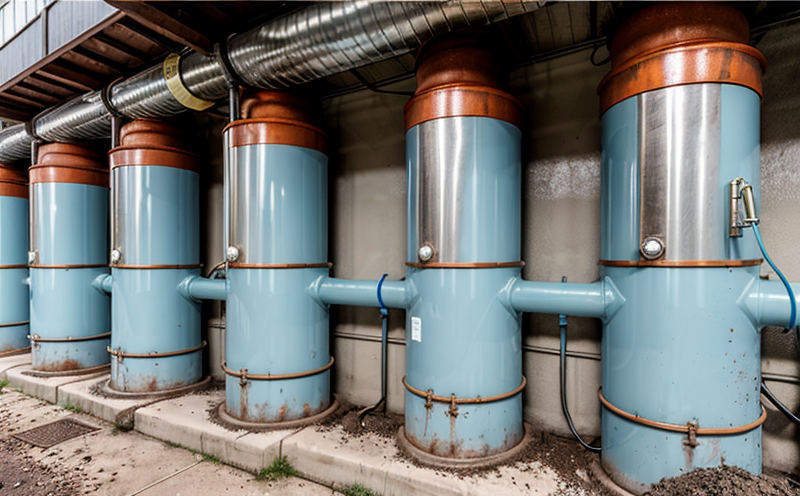ASTM D5673 Iron Test in Water Systems
The ASTM D5673 iron test is a critical procedure used to evaluate the amount of free ferric (Fe³⁺) and ferrous (Fe²⁺) iron present in water systems. This test is particularly important for monitoring the quality, corrosion potential, and overall integrity of potable water systems, industrial processes, and wastewater treatment facilities.
Incorporating ASTM D5673 into your routine testing protocol can help you identify issues related to iron contamination, which can lead to scaling, pipe degradation, and operational inefficiencies. The test is essential for ensuring that water quality meets regulatory standards and industry requirements such as those set by the World Health Organization (WHO), European Union Directives, and various national regulations.
The ASTM D5673 iron test involves several key steps: sample collection, preparation, digestion of the sample to release iron into solution, and subsequent colorimetric analysis. The procedure is standardized to ensure accurate and reproducible results across different laboratories.
Understanding the parameters involved in this test can help you make informed decisions about water treatment processes. For instance, elevated levels of free ferric iron can indicate a higher risk of corrosion and biofilm formation, while ferrous iron suggests potential oxidation reactions that could affect system performance. By monitoring these parameters, you can take proactive measures to mitigate risks associated with iron contamination.
The test results are typically reported in parts per million (ppm) or milligrams per liter (mg/L), depending on the specific application and regulatory requirements. High levels of iron may necessitate additional treatment steps such as filtration, oxidation, or the use of corrosion inhibitors to prevent further degradation of the system.
It is important to note that ASTM D5673 does not address all forms of iron present in water systems; it specifically targets free ferric and ferrous iron. This limitation underscores the need for a comprehensive approach to water quality assessment, incorporating multiple testing methods where necessary.
| Parameter | Description | Unit |
|---|---|---|
| Free Ferric Iron (Fe³⁺) | Iron present in the water as a soluble ion that can cause corrosion and scaling. | ppm/mg/L |
| Ferrous Iron (Fe²⁺) | Iron that is prone to oxidation, leading to potential biofilm formation and operational issues. | ppm/mg/L |
In summary, the ASTM D5673 iron test plays a vital role in ensuring water quality meets both regulatory and practical standards. By incorporating this test into your testing protocol, you can gain valuable insights into the presence and potential impact of free ferric and ferrous iron in your water systems.
Why It Matters
The significance of the ASTM D5673 iron test cannot be overstated, especially for industries heavily reliant on water quality. Iron contamination can lead to a myriad of issues, ranging from aesthetic concerns like discoloration and unpleasant tastes to more serious operational challenges such as pipe corrosion and biofilm formation.
Critical infrastructure such as potable water supplies, industrial processes, and wastewater treatment facilities are particularly vulnerable to the adverse effects of iron. For instance, in potable water systems, high levels of free ferric iron can contribute to the development of red water syndrome, which not only affects consumer satisfaction but also poses risks to public health.
Incorporating ASTM D5673 into your testing regime helps you stay ahead of potential issues by providing early detection of iron contamination. This proactive approach is crucial for maintaining system integrity and ensuring compliance with local, national, and international standards such as those set forth by the WHO and ISO.
The test also aids in optimizing water treatment processes. By identifying specific forms of iron present in the water, you can tailor your treatment strategies to address these issues effectively. For example, if ferrous iron is detected, you may opt for aeration or oxidation methods to convert it into ferric iron before filtration.
In conclusion, the ASTM D5673 iron test is not just a routine analysis but a cornerstone of water quality management. Its importance lies in its ability to provide actionable insights that can prevent costly repairs and maintenance while ensuring consistent delivery of high-quality water.
Quality and Reliability Assurance
- Method Validation: The ASTM D5673 procedure is rigorously validated for accuracy and precision, ensuring reliable results across different laboratories.
- Standard Operating Procedures (SOPs): Implementing standardized protocols minimizes variability in test outcomes, enhancing reliability.
- Calibration: Regular calibration of analytical equipment ensures that all measurements are accurate and consistent.
- Data Validation: Data from the ASTM D5673 iron test is cross-verified with other quality assurance measures to ensure robust results.
- Training: Ensuring personnel are well-trained in the ASTM D5673 procedure guarantees consistent and accurate testing.
The combination of these practices helps maintain high standards of quality and reliability, ensuring that the test results are trustworthy and actionable. By adhering to these guidelines, you can confidently use ASTM D5673 iron test data to inform your water management decisions.
Use Cases and Application Examples
The ASTM D5673 iron test finds application in a wide range of industries and settings. Here are some key examples:
| Setting | Purpose |
|---|---|
| Potable Water Supplies | Ensure public health is protected by identifying iron contamination that could lead to red water syndrome. |
| Industrial Cooling Systems | Detect free ferric and ferrous iron that could cause scaling, corrosion, and biofilm formation. |
| Petrochemical Plants | Monitor iron levels in process streams to prevent equipment fouling and operational inefficiencies. |
| Wastewater Treatment Facilities | Evaluate the effectiveness of treatment processes by monitoring iron levels before and after filtration. |
In each setting, ASTM D5673 provides essential information that can help prevent or mitigate issues related to iron contamination. By leveraging this test, you can ensure your water systems are safe, efficient, and compliant with relevant standards.





